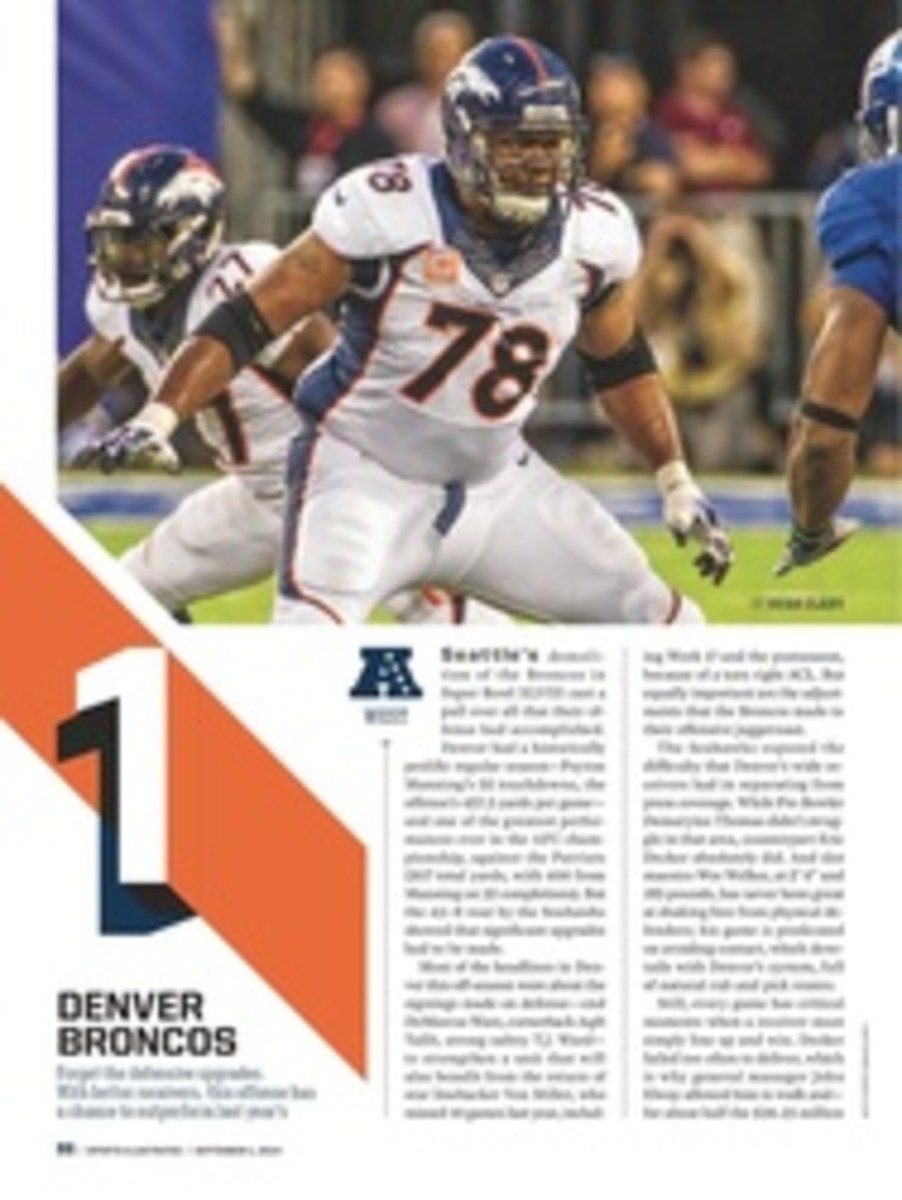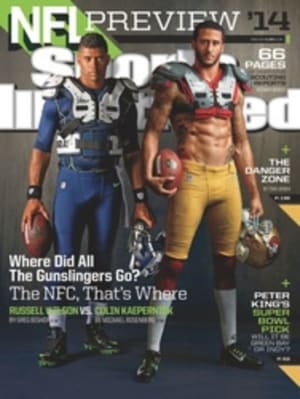
2 SAN FRANCISCO 49ERS
San Francisco recognizes what so many other NFL teams do not: If you're not evolving, you're falling behind. And so, despite having reached the NFC championship game in three straight seasons, Jim Harbaugh's 49ers appear to be updating their offensive approach in 2014. Here's the scary part: Harbaugh (a former quarterback) and coordinator Greg Roman (a one-of-a-kind tactician) are already two of the best running-game architects in football; they should have no trouble improving what's already a crafty passing attack.
To propagate their new approach, GM Trent Baalke, who entered draft week with a league-high 12 picks, dealt a fourth-rounder to the Bills for wideout Stevie Johnson and used another fourth-rounder on South Carolina receiver Bruce Ellington. Johnson, 28, is effective inside but can also play outside, allowing veteran Anquan Boldin to work the slot, where he's most dangerous. That's also where you're likely to see Ellington, who's noted for his quickness, though he may have a tough time leapfrogging those near the top of the depth chart.
There's no confusion, however, over the Niners' primary target: Michael Crabtree will almost never come off the field. With his pliability and quickness, he's the only wideout on the roster who can consistently shake man coverage. The rest of this group—including Johnson and Boldin, who at least can make contested catches—have to be helped by play design.
That's nothing new for Harbaugh and Roman, whose quarterback also requires the aid of play design. Colin Kaepernick's long-striding speed and quick-twitch athleticism give him sensational mobility, and he has a rocket-launcher arm. But these attributes are in constant battle with the 26-year-old's still unrefined fundamentals and limited awareness.
To be blunt: Kaepernick's pocket poise and mechanics are severely underdeveloped. He too often breaks down to run even before reaching the top of his drop. And if his first read isn't open, a play immediately becomes haphazard. His positive traits make him worth the effort, however, so Harbaugh and Roman are forced to design around this and around the fact that Kaepernick, entering his third season as a starter, reads only half the field. Sometimes not even that.
Yet Kaepernick has far exceeded his limitations. In fact, his state of imperfection has led to some mind-boggling improvisations and has helped get San Francisco within sniffing distance of the Lombardi Trophy every year. Keep in mind: Kaepernick has also benefited from a strong defense and running attack. Such tremendous support won't last forever.
So what is Harbaugh to do? Allow his quarterback to play fast and loose and hope that's enough? Or try to build more stability in Kaepernick's game?
Right now the plan seems to be the latter. Roman has intimated that the Niners could use more spread-oriented passing concepts—a scheme he has the resources for, especially considering that his wide receiving corps is buttressed by Vernon Davis. The Pro Bowl tight end attracts extra coverage down the middle and, with his ability to split outside and win one-on-ones, lends versatility to formations.
But while Roman can stay up late concocting the most cutting-edge aerial attack known to man, at some point a truly pass-oriented system is going to demand more sound quarterbacking.
If the Niners want to change their style, they at least have a safety net when Kaepernick flounders: the run-first approach that has served them well the past three years. Running back Frank Gore is 31, but he still operates at a high level. With a game predicated on vision, timing and setting up blocks, he can remain effective even if his speed and quickness abate. Should Gore run out of gas, San Francisco has a similarly styled replacement in this year's second-round pick, Ohio State's Carlos Hyde.
The Niners also re-signed lead blocker Bruce Miller, an invaluable, multifaceted fullback who, along with No. 2 tight end Vance McDonald, provides much of the dimension in a ground game that's long been the league's most powerful and diverse.
That power comes from a front five led by two Pro Bowlers on the left side: tackle Joe Staley and guard Mike Iupati, who broke his left fibula in the NFC championship game but appears to be 100%. And the diversity? That comes from a quarterback who, despite being tremendously green, is still the scariest raw playmaker in the NFL, no matter what system he plays in.
2014 SCHEDULE
2013 Record: 12--4
WEEK 1
DAL [AWAY]
CHI [HOME]
ARI [AWAY]
PHI [HOME]
KC [HOME]
STL MON [AWAY]
DEN [AWAY]
BYE
STL [HOME]
NO [AWAY]
NYG [AWAY]
WAS [HOME]
SEA THUR [HOME]
OAK [AWAY]
SEA [AWAY]
SD SAT [HOME]
ARI [HOME]
WEEK 17
MAJOR CONCERN
The front seven
The future is unclear for inside linebacker NaVorro Bowman, who's unlikely to play before midseason. While referees reviewed a fumble call in the NFC championship game last January, TV viewers cringed as Fox showed a replay of the All-Pro's left leg snapping under a pileup. For years Bowman and Patrick Willis hallmarked the 49ers' stifling nickel-based D with their ability to play man coverage, rare for their positions. With Bowman out, the scheme very well could change—but the pass rush won't. Its foundation: stunts and twists from double-team eaters Justin Smith and Ray McDonald, plus devastating edge attacking by Aldon Smith and Ahmad Brooks. The formidability of these four-man-rush tactics has often negated a need for blitzing. But that won't always be the case in 2014, as Smith is expected to be suspended at some point. When the Niners blitzed in the past, Bowman was often the key guy because he handled the running back in man. Now that versatile force is MIA.
THE CASE FOR
Free safety Eric Reid
The offense isn't the only unit undergoing a change in San Francisco. Long centered around stingy man-to-man, the defense will use a larger range of coverages in 2014. This shift actually began late last season, when coordinator Vic Fangio put his men in a variety of zones, some of them hybrid with man coverage. With three of his top four corners from last year gone, GM Trent Baalke is relying more on the off-season investments he made at safety: Antoine Bethea (from the Colts) and first-round rookie Jimmie Ward (Northern Illinois). Both will play second fiddle to Reid, a 2013 first-round pick who showed last year that he's a ferocious downhill hitter, an instinctive route reader, a ball hawk and an astute student of the game. The Niners are the first team since 1979--80 to draft first-round safeties in consecutive years. All this suggests that San Francisco is committing to more zone concepts (which put added weight on a safety's deployment) but also to a three-safety dime package. That will replace the two-linebacker nickel that's been key to this D's success, but that was weakened by the loss of linebacker NaVorro Bowman. These are dramatic changes—changes that probably wouldn't happen if Reid hadn't shown star potential.
PHOTO
SIMON BRUTY/SPORTS ILLUSTRATED
WR MICHAEL CRABTREE
PHOTO
DILIP VISHWANAT/GETTY IMAGES
NINTEEN PHOTOS

